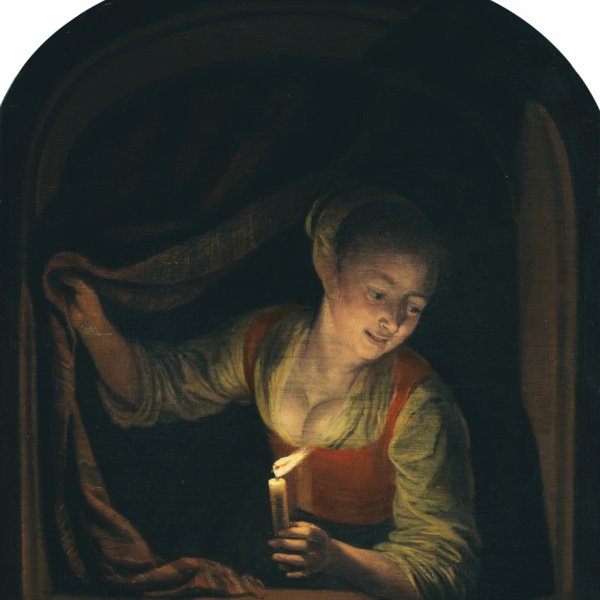Gerrit Dou
Leiden, 1613-1675
Son of Douwe Jansz., a stained-glass designer and printmaker, Gerrit Dou was born in Leiden in 1613. He initially worked with his father and is registered in the guild of stained-glass makers between 1625 and 1627. In 1628, at the age of fifteen, he embarked on a period of training in Rembrandt’s studio, remaining there for three years. Influenced by that artist, Dou’s first works conform to the Leiden tradition with its high degree of finish and use of small formats.
When Rembrandt moved to Amsterdam in 1631 Dou set up as an independent master in his native city, remaining there for the rest of his life. Over the following years he refined his technique, perfecting the enamel-like surface of his works that characterise his output and increasingly focusing on small details. Dou was a founder member of the guild of Saint Luke in Leiden and a second lieutenant in the local militia.
In 1647 Dou painted The Stallholder (Musée du Louvre, Paris), introducing a new sub-genre known as “window paintings” that depict a figure or a scene presented through the opening of a window. In the late 1650s he focused increasingly on effects of light, in particular through two types of nocturnal scene: artificially illuminated genre scenes and female figures in front of a window lit by a single candle or lamp. Dou had a wide repertoire of subjects in addition to his portraits and genre scenes, including figures, animals and still lifes. He was also one of the few 17th-century Dutch painters to depict nudes.
Dou’s success during his lifetime brought him numerous pupils and followers including Gabriel Metsu, Frans van Mieris the Elder and Gottfried Schalken and his fame extended beyond the Low Countries. Dou’s clients included Queen Christina of Sweden, the Archduke Leopold William and Charles II of England.
When Rembrandt moved to Amsterdam in 1631 Dou set up as an independent master in his native city, remaining there for the rest of his life. Over the following years he refined his technique, perfecting the enamel-like surface of his works that characterise his output and increasingly focusing on small details. Dou was a founder member of the guild of Saint Luke in Leiden and a second lieutenant in the local militia.
In 1647 Dou painted The Stallholder (Musée du Louvre, Paris), introducing a new sub-genre known as “window paintings” that depict a figure or a scene presented through the opening of a window. In the late 1650s he focused increasingly on effects of light, in particular through two types of nocturnal scene: artificially illuminated genre scenes and female figures in front of a window lit by a single candle or lamp. Dou had a wide repertoire of subjects in addition to his portraits and genre scenes, including figures, animals and still lifes. He was also one of the few 17th-century Dutch painters to depict nudes.
Dou’s success during his lifetime brought him numerous pupils and followers including Gabriel Metsu, Frans van Mieris the Elder and Gottfried Schalken and his fame extended beyond the Low Countries. Dou’s clients included Queen Christina of Sweden, the Archduke Leopold William and Charles II of England.




